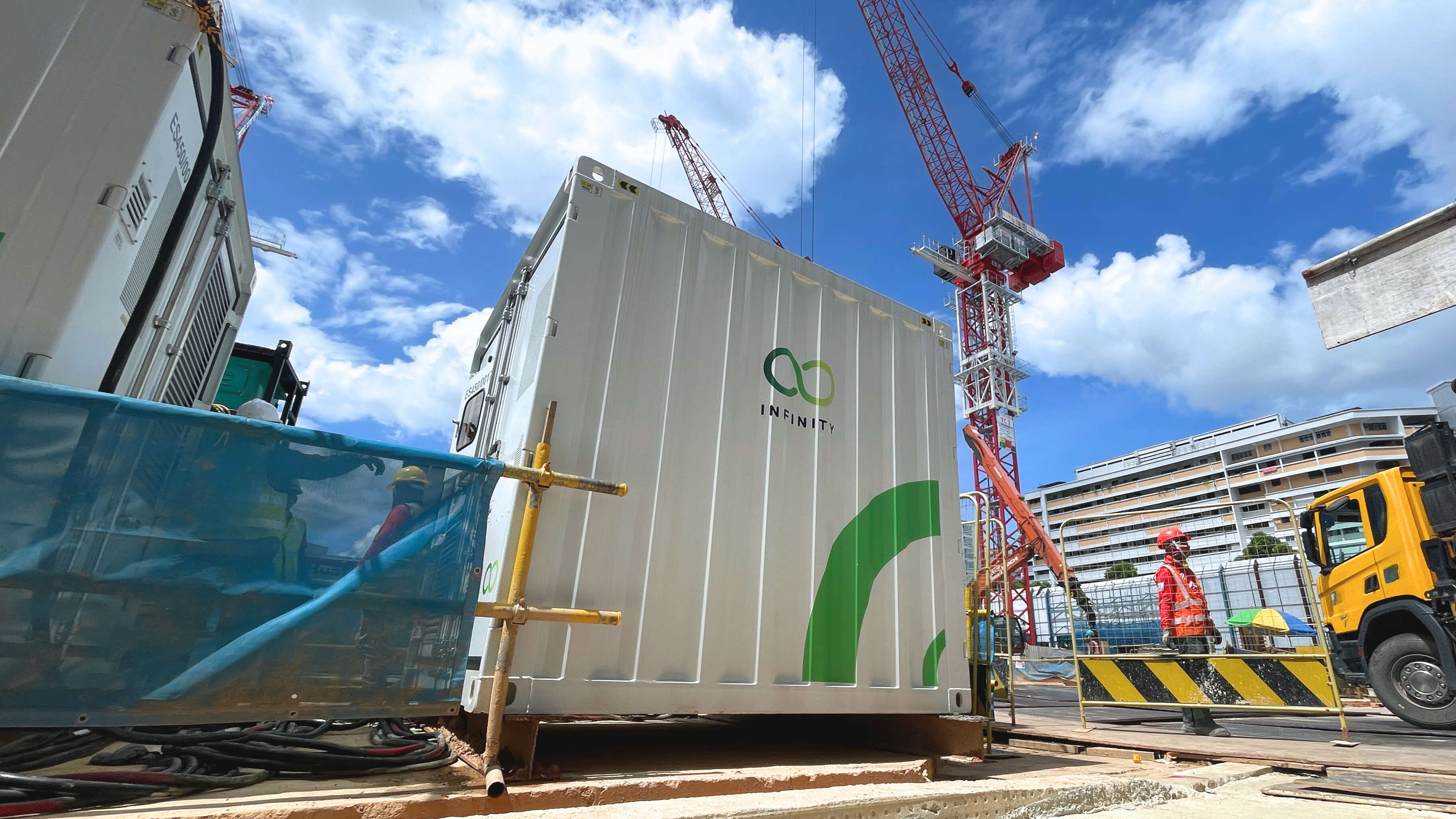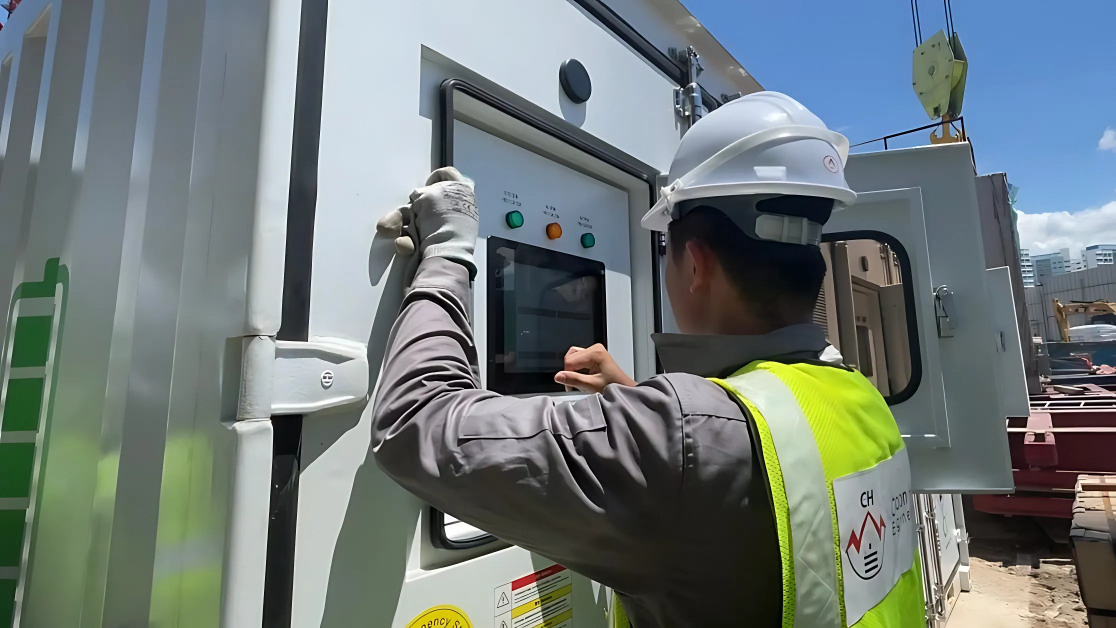Grand Dunman, an upcoming condominium near Dakota MRT station in eastern Singapore, looks like any other project under construction with its bright red passenger hoists and tower cranes.
But operations are cleaner, quieter, and greener, thanks to the implementation of battery energy storage systems (BESS). Unlike conventional fuel-intensive diesel generators, BESS discharges power as needed to site equipment through its stored energy management system and power conversion system, resulting in a more cost-efficient power source.
Moreover, BESS is more sustainable and produces up to 90 per cent less carbon emissions than diesel generators. With its BESS technology, Infinity Cube – a joint venture between local construction equipment rental company Choon Huat Engineering and a Chinese manufacturer – hopes to help the local construction sector reduce its reliance on fossil fuels and save costs in the process.
BESS vs. Diesel Generators
Contractor of Grand Dunman, China Construction Realty, had used diesel generators as the main power source when work first started. But burning 1,140 litres of diesel daily racked up costs of $65,000 monthly, chalking up more than 1.2 million kg worth of carbon dioxide emissions annually.
That was when the contractor learnt about Infinity Cube’s BESS. The product, launched in 2023, is also named Infinity Cube.
Taking the leap, it installed four Infinity Cubes – three medium and one large – on site. This helped to cut down the number of diesel generators used from 21 to two, reducing operating costs and carbon emissions significantly, said Infinity Cube’s Chief Executive Officer Oh Jun Rong.

An L-sized Infinity Cube deployed on site
Adopting sustainable systems such as BESS is crucial in helping Singapore achieve its sustainability targets as outlined in the Singapore Green Building Masterplan (SGBMP). The built environment sector accounts for over 20 per cent of carbon emissions in Singapore. To reduce these emissions, the SGBMP aims to green 80 per cent of buildings by 2030, achieve 80 per cent of new developments (by GFA) to be Super Low Energy (SLE) buildings from 2030 and to achieve 80 per cent improvement in energy efficiency (compared to 2005 levels) for best-in-class green buildings by 2030.Schemes such as the Energy Efficiency Grant (EEG) are helpful for companies interested in exploring sustainable solutions, said Mr Oh. The firm’s BESS – is a pre-approved solution for companies applying for EEG – is now more accessible to contractors, allowing them to green their operations without breaking the bank.
“By offering financial support (through EEG), we believe that it can encourage more companies to invest in sustainable solutions to lower their operating costs and environmental impact,” he added.
Ahead of the curve
While most contractors are keen to green operations on site, balancing costs and carbon emissions remains a struggle.
For instance, installing a power grid is more sustainable, but it is too costly for short-term projects. On the other hand, diesel generators, while less green, are more affordable than power grids. As a result, they remain a popular choice for contractors, Mr Oh noted.
With BESS– replacing diesel generators as the main power source, it can help contractors reap significant energy savings and reduce their carbon footprint.
“In the best scenario, the BESS can save up to 85 per cent of carbon emissions,” said Mr Oh.
The Infinity Cube’s BESS takes innovation a step further with its power conversion system (PCS), a first in Singapore which was developed in-house.
“Our PCS is able to synchronise, (it’s) a special feature that we’ve developed. It is able to combine power with the power grid. Not all BESS can do this,” said Mr Oh.
Conventional BESS can only discharge as much power as their charged battery, and power stored in the grid is usually unused. But Infinity Cube’s PCS taps on this dormant power, allowing the BESS to discharge more power.
Infinity Cube’s BESS also boasts another unique feature: an exclusive cloud monitoring platform. On site, contractors can use the platform to track power usage, diesel used, and carbon emissions saved.
“It’s an app that helps our clients to see whether the battery is working and how much power is being used. From there, they can basically gather the data (to meet their sustainability targets),” said Mr Oh.

Monthly physical routine checks on the BESS
Infinity Cube will continue to integrate new features for better customer experience on the app, with new functions such as remote system control, which are set to be rolled out at the end of 2025.
Mr Oh is heartened that his company’s BESS has helped at least 20 local contractors cut carbon emissions and operating costs. “Once they’ve tried (our BESS and seen its results), they never stop (using it),” he said with a laugh.
BCA’s Energy Efficiency Grant (EEG) is now opened for applications. Interested applicants can apply through the Business Grants Portal (BGP) (https://www.businessgrants.gov.sg/). The full eligibility criteria, supportable energy-efficient equipment and FAQs can also be found on the GoBusiness webpage (https://www.gobusiness.gov.sg/energy-efficiency-grant/). For information on other support schemes managed by BCA under BuildSG Transformation Fund, please visit go.gov.sg/btf.